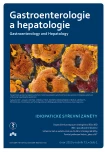Surprising etiology of terminal common bile duct stricture
Authors:
Vašíček J.; Horný I.
Authors‘ workplace:
Interní oddělení, gastroenterologie, Nemocnice Strakonice, a. s.
Published in:
Gastroent Hepatol 2019; 73(1): 52-55
Category:
Clinical and Experimental Gastroenterology: Case Report
doi:
https://doi.org/10.14735/amgh201952
Overview
The authors present a case report of a patient with unclear terminal common bile duct stenosis, presenting as jaundice and repeatable acute cholangitis. They describe procedures used to identify the etiology of stenosis. They exclude malignant etiology and pursue a differential diagnosis of stenosis with benign etiology. Nevertheless, it was necessary to perform autopsy (due to rapid progression of the patient’s health), which revealed adenocarcinoma of the gallbladder, with dissemination to the duodenum, pancreas, lymph nodes, lungs, and bile duct, resulting in stenosis of ductus choledochus. The authors discuss gallbladder cancer, incidence, risk factors, diagnostics, and therapy.
Key words:
common bile duct – stricture – gallbladder – malignancy
Submitted: 1. 10. 2018
Accepted: 1. 1. 2019
The authors declare they have no potential conflicts of interest concerning drugs, products, or services used in the study.
The Editorial Board declares that the manuscript met the ICMJE „uniform requirements“ for biomedical papers.
Sources
1. Nguyen Canh H, Harada K. Adult bile duct strictures: differentiating benign biliary stenosis from cholangiocarcinoma. Med Mol Morphol 2016; 49(4): 189– 202. doi: 10.1007/ -s00795-016-0143-016.
2. Dušek L, Mužík J, Kubásek M et al. Epidemiologie zhoubných nádorů v České republice. Masarykova univerzita (2005). [online]. Dostupný z: http://www.svod.cz.
3. Vyzula R (ed). Modrá kniha České onkologické společnosti. [online]. Dostupný z: https:/ / www.linkos.cz/ files/ modra-kniha/ 17.pdf.
4. Ioannidis O, Paraskevas G, Varnalidis I et al. Primary gallbladder cancer discovered postoperatively after elective and emergency cholecystectomy. Klin Onkol 2013, 26(1): 31– 34. doi: 10.14735/ amko201331
5. Fujii M, Saito H, Shiode J et al. Rare case of gallblader neuroendocrine carcinoma. [online]. Clin J Gastroenterol 2019; 12(1): 38– 45. Available from: https:/ / link.springer.com/ article/ 10.1007/ s12328-018-0883-z. doi: 10.1007/ s12328-018-0883-z.
6. Mareček Z, Procházka V, Vaňásek T et al. Choroby žlučníku a žlučových cest. In: Ehrmann J, Hůlek P (eds). Hepatologie. Praha: Grada Publishing 2010: 563.
7. Kanthan R, Senger JL, Ahmed S et al. Gallbladder cancer in the 21st century. J Oncol 2015; 2015: 967472. doi: 10.1155/ 2015/ 967472.
8. Ejaz A, Sachs T, Ihab R Kamel et al. Gallbladder Cancer – Current Management Options. Oncology & Hematology Review (US), 2013; 9(2): 102– 108. doi: http:/ / doi.org/ 10.17925/ OHR.2013.09.2.102.
9. Ramos-Font C, Gómez-Rio M, Rodríguez-Fernández A et al. Ability of FDG-PET-CT in the detection of gallbladder cancer. J Surg Oncol 2014; 109(3): 218– 224. doi: 10.1002/ jso.23476.
10. Urban O, Fojtík P, Mikolajek O et al. Renesance cholangiopankreatoskopie a nové možnosti intraduktální endoskopické terapie. Gastroent Hepatol 2016; 70(3): 203– 207. doi: 10.14735/ amgh2016203
Labels
Paediatric gastroenterology Gastroenterology and hepatology SurgeryArticle was published in
Gastroenterology and Hepatology

2019 Issue 1
Most read in this issue
- Clensia® – the first combined cleansing agent with simeticone
- Toxic and drug damage of the liver and kidneys
- Surprising etiology of terminal common bile duct stricture
- Therapeutic trial of proton pump inhibitors for management of patients with laryngopharyngeal reflux
